 Backend Development
Backend Development
 Python Tutorial
Python Tutorial
 Detailed explanation of Python shallow copy, deep copy and reference mechanism
Detailed explanation of Python shallow copy, deep copy and reference mechanism
Detailed explanation of Python shallow copy, deep copy and reference mechanism
I encountered some problems this week, and then I realized that if the basic knowledge has not been consolidated for a period of time, there are still forgotten parts that still need to be reviewed. I will make a note here to record it
Previous Continue
Let’s briefly describe the problem encountered. The requirement is to write the results of 2 prints 
As you can see, a points to a list list object, in Python, such an assignment statement actually means that a points to the memory address where the list is located, which can be regarded as a concept similar to a pointer.
And b, please note that it wraps the a object into a list and multiplies it by 5, so b should look like a big list with all the elements in it. When the a object After the append operation is performed, in fact, the implicit meaning is that the list in the memory has been modified, and all objects that reference this object will change
I print out the id of a, and , and print the id of element a contained in the object b, so that you can see that in the list b, the id of each element is the same as a We can see that the id (memory address) of object a is 10892296. Although b wraps a into a new list, this element still refers to the object with the same address. This can be explained by the following figure
We can see that the id (memory address) of object a is 10892296. Although b wraps a into a new list, this element still refers to the object with the same address. This can be explained by the following figure 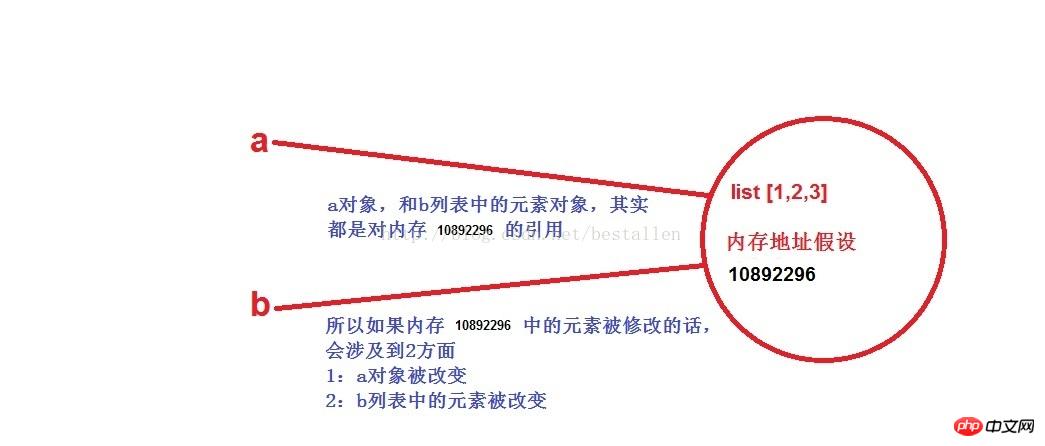 After that, we performed the append operation on a. Since list is a variable object, its memory address has not changed, but the reference to this address in the memory All objects will be changed together, which can be seen from the lower half of the dividing line in the test chart above.
After that, we performed the append operation on a. Since list is a variable object, its memory address has not changed, but the reference to this address in the memory All objects will be changed together, which can be seen from the lower half of the dividing line in the test chart above.
This leads to a review of the Python reference mechanism and shallow copy and deep copy
Python’s reference mechanism
Reference mechanism case 1
From the above example, we can see that python Pass by reference, the final result is to have two objects refer to the contents of the same area in the memory
So let's take a look at the following example
B passes A, and also references the id of 17446024 The content of the address and the ID (memory address) of the two are exactly the same
So, through the operation of A A[0]=3 or A[3].append(6), it will be correct The contents in this memory are modified (because list is a variable object, so the memory address will not change, which will be discussed later)
This is the most basic reference case (in addition, since A and B all points to the same memory address, so the content modified by B can also be reflected on A)
Reference mechanism case 2
Let’s look at another case
Looking at the question, it seems that element 2 will be replaced with the list itself. The result may be A=[1,[1,2,3],3]
But it’s not! ! You can see that in the red box, there are infinite number of nested
Why is this happening?
In fact, it is because A points to the list [1,2,3]. In this example, only the second element of A points to the A object itself, so it is only the second element of A. The structure has changed! However, A still points to that object
We can see by printing the id of A that its pointing has not changed! ! 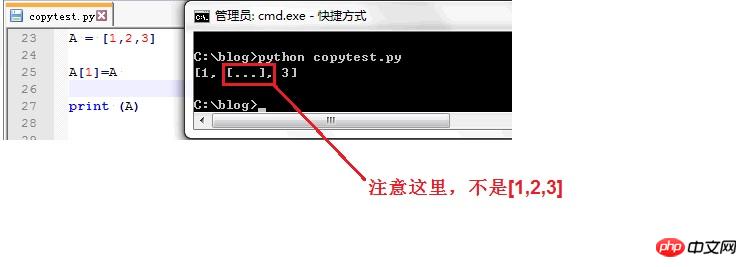 Let’s take a look, the direction of A has not changed
Let’s take a look, the direction of A has not changed Then if we want to achieve the final output effect, it is [ 1, [1,2,3],3], how should we operate it?
Then if we want to achieve the final output effect, it is [ 1, [1,2,3],3], how should we operate it?
Here, we will use shallow copy. The usage can be as follows
Shallow copy and deep copy
Shallow copy
Now, let’s talk about shallow copy and deep copy. The above method actually only performs shallow copy, shallow copy, which means that it copies the original referenced object, but no longer references the same object address
Look at the example below. B performs a shallow copy through the B = A[:] operation. You can see that after the shallow copy, the memory addresses referenced by A and B are already different
However, the reference addresses of the elements inside A and B are still the same, so be very careful about this! There is a difference! ! !
The difference in the reference memory addresses of A and B means that the operation you perform on B will not affect A. 
Shallow copy summary:
So shallow copy can be summarized as copying a reference, the new object and the original The object references are distinguished, but the address references of the internal elements are still the same
But shallow copying will also have problems. What is the problem? It is when there is nesting. For example, as you can see in the following situation, I assigned a shallow copy of A to B, so that the IDs (memory addresses) of A and B are different.
So, when I modify A[0]=8, B will not be affected, because A and B are independent references, but there is a nested list in the middle [4 ,5,6]
We can understand this [4,5,6] as: A and B still reference together, that is, for the second elements of A and B, they still point to the same A memory address.
In addition, since int is an immutable type, after changing A[0] to 8, its reference address will change! It is distinguished from the reference of the element B[0]. 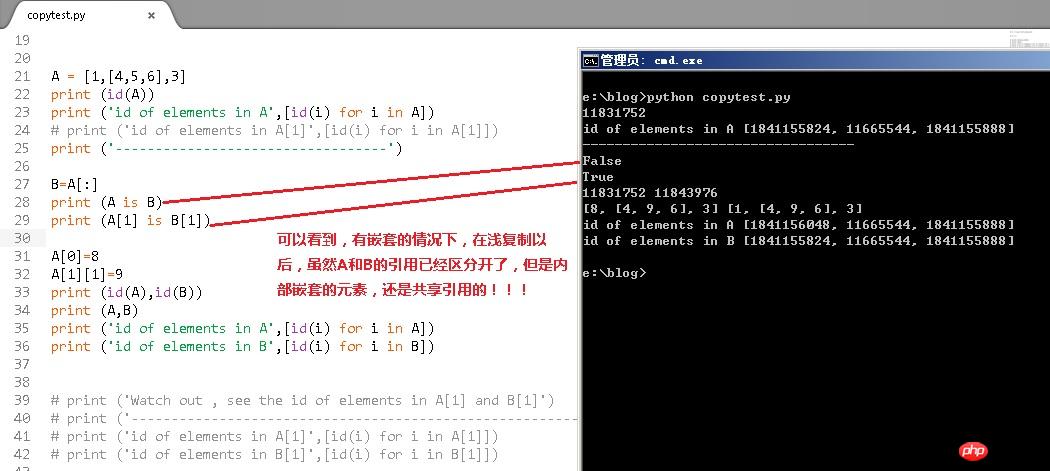
Deep Copy
So how to face such a situation? We need to use the copy module in the python module
The copy module has 2 functions
1: copy.copy (the object you want to copy): This is a shallow copy, and the previous one The nature of the [:] operation on the list is the same
2: copy.deepcopy (the object you want to copy): This is a deep copy, except that it will generate a new object just like the shallow copy. References, and for internal elements, new references will be generated to separate them independently.
Look at the example below, when you assign a deep copy of A to B, they can be said to be completely independent. , whether you modify the immutable elements in A, or modify the nested mutable elements in A, the result will not affect B
My understanding is: deep copy can be called recursive copy, He will copy all nested variable elements and then reference them independently.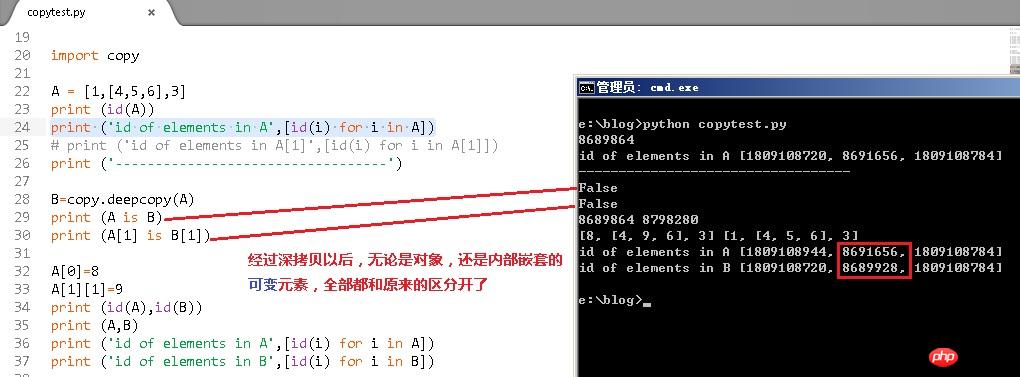
Deep copy summary:
The effect of deep copy is the same as that of shallow copy. In addition to generating a new reference from the object's reference, it will help you open all the nested elements one by one.
I drew 2 pictures myself Figure to show the difference between the effects of shallow copy and deep copy
It should be noted that although after shallow copy, the reference address of the immutable elements in the list is still the same, but because they are immutable elements, Therefore, after any immutable element is changed, the reference address will be new without affecting the original reference address. 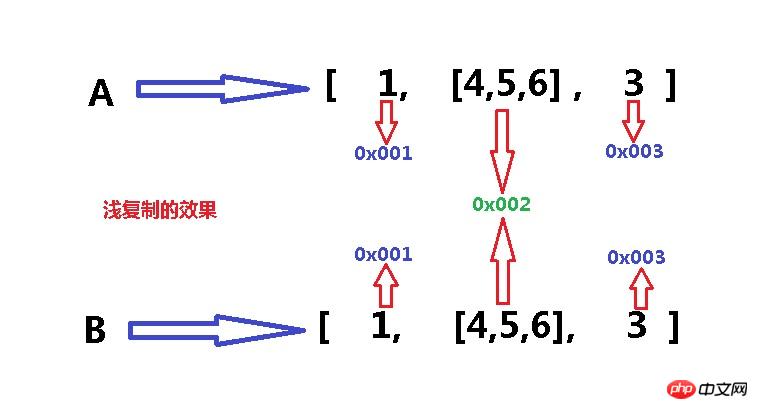
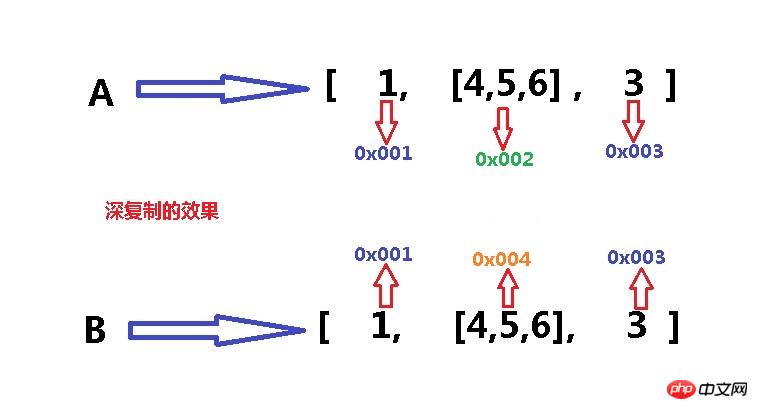
##Summary
So, here we go, shallow copy And the mechanism of deep copy is basically understood.
There are also special circumstances that need to be explained
For immutable types: int, str, tuple, float and other elements, there is no copy. After they are modified, the reference address is Directly changed, as shown below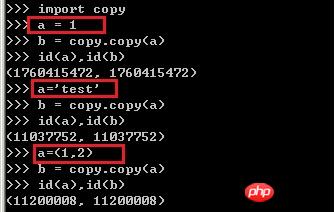
However, if there are nested variable types inside the immutable type, you can still use deep copy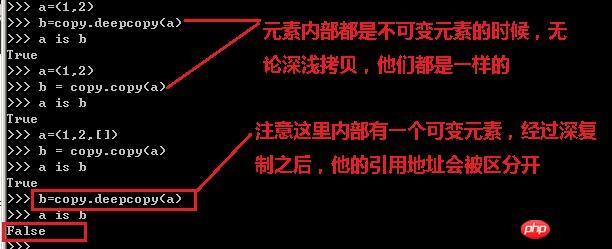
Also a reminder, the method we usually use most is direct assignment (or direct passing of references), such as the following example
He combines a and b Two variable elements point to a memory address at the same time, so any change will affect a and b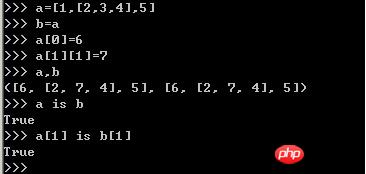
Finally
Variable type: list , set, dict
Immutable types: int, str, float, tuple
Shallow copy method: [:], copy.copy(), use factory function (list/dir/set )
Deep copy method: copy.deepcopy()
The above is the detailed content of Detailed explanation of Python shallow copy, deep copy and reference mechanism. For more information, please follow other related articles on the PHP Chinese website!

Hot AI Tools

Undresser.AI Undress
AI-powered app for creating realistic nude photos

AI Clothes Remover
Online AI tool for removing clothes from photos.

Undress AI Tool
Undress images for free

Clothoff.io
AI clothes remover

Video Face Swap
Swap faces in any video effortlessly with our completely free AI face swap tool!

Hot Article

Hot Tools

Notepad++7.3.1
Easy-to-use and free code editor

SublimeText3 Chinese version
Chinese version, very easy to use

Zend Studio 13.0.1
Powerful PHP integrated development environment

Dreamweaver CS6
Visual web development tools

SublimeText3 Mac version
God-level code editing software (SublimeText3)

Hot Topics
 1666
1666
 14
14
 1425
1425
 52
52
 1328
1328
 25
25
 1273
1273
 29
29
 1253
1253
 24
24
 PHP and Python: Different Paradigms Explained
Apr 18, 2025 am 12:26 AM
PHP and Python: Different Paradigms Explained
Apr 18, 2025 am 12:26 AM
PHP is mainly procedural programming, but also supports object-oriented programming (OOP); Python supports a variety of paradigms, including OOP, functional and procedural programming. PHP is suitable for web development, and Python is suitable for a variety of applications such as data analysis and machine learning.
 Choosing Between PHP and Python: A Guide
Apr 18, 2025 am 12:24 AM
Choosing Between PHP and Python: A Guide
Apr 18, 2025 am 12:24 AM
PHP is suitable for web development and rapid prototyping, and Python is suitable for data science and machine learning. 1.PHP is used for dynamic web development, with simple syntax and suitable for rapid development. 2. Python has concise syntax, is suitable for multiple fields, and has a strong library ecosystem.
 How to run sublime code python
Apr 16, 2025 am 08:48 AM
How to run sublime code python
Apr 16, 2025 am 08:48 AM
To run Python code in Sublime Text, you need to install the Python plug-in first, then create a .py file and write the code, and finally press Ctrl B to run the code, and the output will be displayed in the console.
 PHP and Python: A Deep Dive into Their History
Apr 18, 2025 am 12:25 AM
PHP and Python: A Deep Dive into Their History
Apr 18, 2025 am 12:25 AM
PHP originated in 1994 and was developed by RasmusLerdorf. It was originally used to track website visitors and gradually evolved into a server-side scripting language and was widely used in web development. Python was developed by Guidovan Rossum in the late 1980s and was first released in 1991. It emphasizes code readability and simplicity, and is suitable for scientific computing, data analysis and other fields.
 Python vs. JavaScript: The Learning Curve and Ease of Use
Apr 16, 2025 am 12:12 AM
Python vs. JavaScript: The Learning Curve and Ease of Use
Apr 16, 2025 am 12:12 AM
Python is more suitable for beginners, with a smooth learning curve and concise syntax; JavaScript is suitable for front-end development, with a steep learning curve and flexible syntax. 1. Python syntax is intuitive and suitable for data science and back-end development. 2. JavaScript is flexible and widely used in front-end and server-side programming.
 Golang vs. Python: Performance and Scalability
Apr 19, 2025 am 12:18 AM
Golang vs. Python: Performance and Scalability
Apr 19, 2025 am 12:18 AM
Golang is better than Python in terms of performance and scalability. 1) Golang's compilation-type characteristics and efficient concurrency model make it perform well in high concurrency scenarios. 2) Python, as an interpreted language, executes slowly, but can optimize performance through tools such as Cython.
 Where to write code in vscode
Apr 15, 2025 pm 09:54 PM
Where to write code in vscode
Apr 15, 2025 pm 09:54 PM
Writing code in Visual Studio Code (VSCode) is simple and easy to use. Just install VSCode, create a project, select a language, create a file, write code, save and run it. The advantages of VSCode include cross-platform, free and open source, powerful features, rich extensions, and lightweight and fast.
 How to run python with notepad
Apr 16, 2025 pm 07:33 PM
How to run python with notepad
Apr 16, 2025 pm 07:33 PM
Running Python code in Notepad requires the Python executable and NppExec plug-in to be installed. After installing Python and adding PATH to it, configure the command "python" and the parameter "{CURRENT_DIRECTORY}{FILE_NAME}" in the NppExec plug-in to run Python code in Notepad through the shortcut key "F6".



